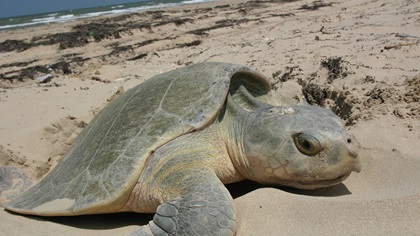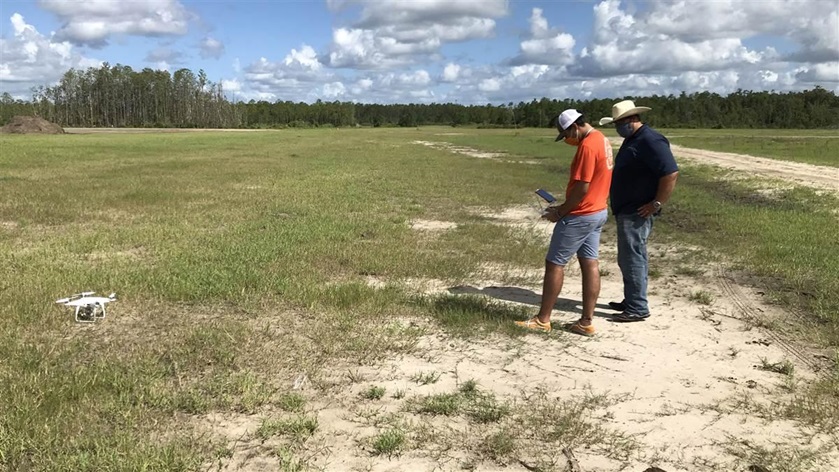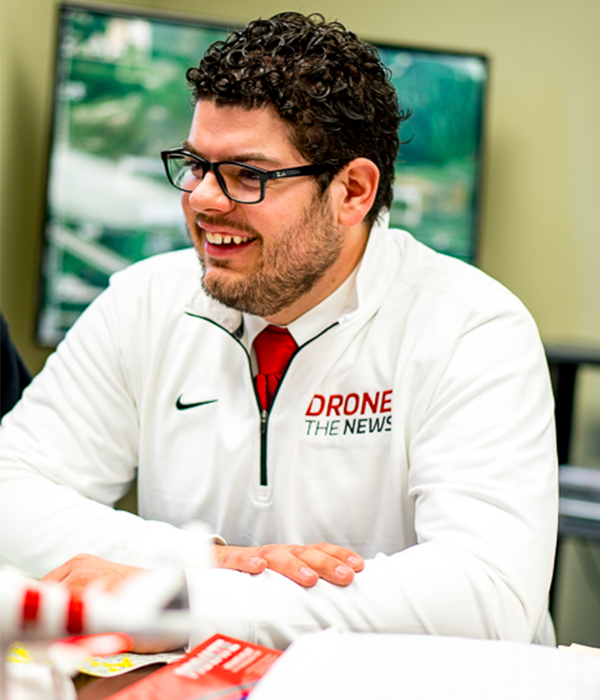Saving turtles also salvages senior year
ERAU students join conservation effort
Andrés Larrota was stuck, but the plight of endangered sea turtles and a high-tech approach to keeping tabs on them with unmanned aircraft proved opportune.
Embry-Riddle Aeronautical University's Daytona Beach, Florida, campus is within easy reach of the world’s most popular loggerhead turtle nesting sites along the state’s eastern shore. Not much was easy to reach in the early stages of the coronavirus pandemic, however, with shutdowns, social distancing, and travel off the table for many. Embry-Riddle moved classes online and shut down flight operations.
Larrota has been aiming to become a professional pilot since his first encounter with aviation as a child, a six-hour red-eye flight from Colombia to New York that lit the spark.
“I did not sleep a single minute. I was just looking out the window to see what was going on and listen to all of the noises,” said Larrota, in a recent video chat.
That sleepless flight eventually led Larrota to Embry-Riddle, where he quickly earned his private pilot certificate and an instrument rating. Then, he discovered the school’s unmanned aviation offerings as a sophomore.
Larrota has a unique connection to unmanned aircraft systems: His father works in Colombia as a land surveyor and uses unmanned aircraft for photogrammetry and topography work. Larrota’s father gave the young pilot a DJI Phantom 4, and that proved to be enough to nudge him onto a new course studying UAS.
 Larrota was lined up for a study-abroad trip to the Balkan Peninsula when the pandemic struck, planning to join a team of professors and fellow students on a project to survey archaeological sites with UAS, and develop urban air mobility concepts as well.
Larrota was lined up for a study-abroad trip to the Balkan Peninsula when the pandemic struck, planning to join a team of professors and fellow students on a project to survey archaeological sites with UAS, and develop urban air mobility concepts as well.
“That was going to be my first hands-on experience,” Larrota said. “When the coronavirus hit I was left with nothing.”
He was stuck in Florida with time on his hands and not much to do, until he remembered a conversation with professor John Robbins, and decided to follow up. Robbins is Embry-Riddle's unmanned aircraft systems program coordinator, and he had an opening on a team of eight students being assembled for a turtle conservation mission to work alongside staff from Northrop Grumman and the Brevard Zoo. The collaborative effort, known as “Turtle Tech,” seeks to learn more about the types of turtles inhabiting Florida’s Space Coast, and their nesting patterns.
Turtles might not be suffering the consequences of the coronavirus, but they do have other problems. While sea turtles might lay 100 eggs or more in each nest, biologists estimate that only one in 1,000—and perhaps as few as one in 10,000—hatchlings will reach adulthood. The reasons range from racoons to artificial lighting on beaches, and this attrition threatens the survival of many species of sea turtles.
That’s where Turtle Tech comes in. The program is working to launch a sophisticated surveillance effort to provide crucial conservation insights by documenting hatching events and migration behavior on a massive scale with minimal personnel. Turtle Tech has earned buy-in from several corporate, educational, and governmental organizations including the National Oceanic and Atmospheric Administration and the Sea Turtle Conservancy, among others.
“This just has the potential to bring out so much cool work and do some really good things for the turtles and conservation in general,” Robbins said in a video chat.
Larrota dug into this newfound opportunity with gusto, and spent much of the summer crafting procedures, researching airspace, and assessing the available unmanned aircraft technology.
Turtle Tech will use two types of unmanned aircraft systems to fly: the Applied Aeronautics Albatross, a fixed-wing platform with vertical takeoff and landing capability, and DJI quadcopters including the Matrice 210 for turtle close-ups. The versatile quadcopter can carry multiple payloads and capture detailed images of sea turtles, while the fixed-wing Albatross can cover more ground and loiter much longer, with endurance of up to about four hours per flight.
The two aircraft types will work in tandem, with the Albatross scanning a wide swath to locate turtles of interest up to 12 miles offshore, and the Matrice 210 closing in on turtles spotted by the Albatross to capture detailed images of the marks and patterns on the turtle shells, detail that will allow animal identification to be automated.
Richard Beers serves as a program and offshore leader for Northrop Grumman. He noted in a press release that unlike most drone-based surveillance efforts this tandem approach will yield far more data in a short time than would have been possible by more traditional means: ”This sequential approach will allow the team to populate a sea turtle database—without having to capture and attach tracking devices to each animal.”
The Embry-Riddle students have spent the past few months preparing the drones for launch by replacing servos, working on the airframes, and conducting test flights. Larrota looks forward to the moment when the entire team takes off for the first time: “How everyone came together to accomplish this one mission is what I’ve been most excited for.”
Like many unmanned aircraft missions, the data analysis piece is where much of the Turtle Tech magic will happen. Images captured by the aircraft will be loaded into a “neural network,” a powerful artificial intelligence platform trained to automatically identify turtles pictured in the vast trove of data. As turtles are identified, the system will match location data to the digitally captured turtles in the database. Engineers hope that this sophisticated survey will deliver insight about turtle behavior and movements that will help them more precisely target future efforts to preserve the population.
For Larrota, the project has given him confidence that he made the right decision transitioning from manned aviation to unmanned: “It’s surreal... To give information to biologists and researchers is the most exciting part of this, it's actually making a difference for the animals.”
Student success is what inspires Robbins in the classroom.
“It’s a great experience to see them start to make the connection points; they’ve learned how to do this and now they’re applying it to the field,” he said. “The fusion between those two elements reminds us that we’ve done things right.”





